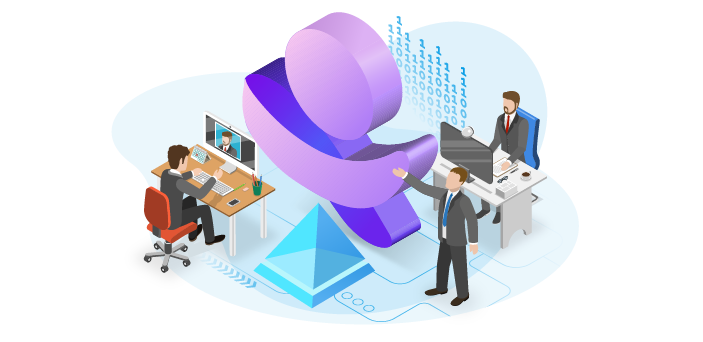The future landscape for collaboration with Microsoft 365 is teeming with exciting possibilities, promising to influence the way teams collaborate and work together.
In a previous blog post on the trends to look out for in 2024 in the cloud collaboration governance space, I briefly touched upon the aspect of collaboration. I wrote that in 2024 and beyond, we can expect to see improvements in real-time collaboration, enhanced communication and collaboration capabilities to bridge geographical and other boundaries.
In this blog post, we’ll dig a little deeper into Microsoft 365 collaboration opportunities by examining the Microsoft 365 product roadmap and theorizing how Microsoft perceives collaboration and modern workplace in the new year.
Focus on enabling collaboration
In an article titled ‘Perspectives on 2023,’ Jeff Teper - President of Microsoft 365 Collaborative Apps and Platforms, re-emphasizes Microsoft’s mission ‘’to empower every person and organization on the planet to achieve more working together.’’
Microsoft 365, formerly known as Office 365, is not just a set of isolated, independent tools, but an integrated experience of apps and services designed to empower collaboration within and across teams. Having evolved into an ever-expanding suite of tools and services hosted in the cloud over the years, Microsoft 365 closely integrates with Microsoft's Azure cloud, Dynamics 365, Power Platform, and Teams to provide a cohesive set of solutions.
Based on this statement, we can expect to see a deeper integration across Microsoft 365 applications in 2024, namely seeing newer technologies such as Copilot and the revamped Viva joining current tools like Teams, SharePoint, and OneDrive, and Power Platform working seamlessly together. Let's take a look at the possibilities in more detail.
AI & Copilot
In the previous article, I mentioned AI as a crucial advancement that has already started to revolutionize cloud collaboration and the way we work. End of 2022 saw the launch of ChatGPT and the overwhelming manner in which it was adopted by individuals for personal use as well as larger teams for professional use.

In the Microsoft realm, Copilot seems to be taking centre stage for the company, given the feature updates and releases planned for the new year. From new releases in Microsoft Viva, Teams, and Power BI, Copilot integration is expected to greatly improve the way teams collaborate.
At Microsoft Ignite in November 2023, Microsoft announced new experiences in Viva Engage, including Copilot in Viva Engage which leverages AI to help create timely, relevant, and engaging posts. It is expected to available in public preview at the beginning of 2024. A quick glance over the Microsoft roadmap for this year and you find two recurring threads – Copilot and Microsoft Viva, both of which are aimed at making collaboration technologically advanced and as smooth as possible.
Once again, the question of rate of adoption comes into play. The licensing cost of Microsoft Copilot – which is an additional service on top of E3 or E5 licenses (at $36 and $57 per user per month respectively) doesn’t necessarily feel light on the pocket. Especially for small and medium-sized companies, considering the minimum of 300 seats at $30 per user per month.
The minimum of 300 seats requirement doesn’t technically stop smaller companies from purchasing Copilot for Microsoft 365, but this puts them in a tough position to justify the return on investment. At least for the foreseeable future, Microsoft doesn’t seem to have any plans to slash the license cost per user, which brings into fore, the rate of Copilot adoption.
With the adoption of AI tools by teams big and small alike, the topic of access and permissions also become all the more relevant.
You can read more about this in Microsoft 365 roadmap here. We’ve summarized a few feature updates and integrations below:
Power BI: Microsoft Copilot Dashboard from Viva Insights
Power BI: Microsoft Copilot Dashboard from Viva Insights – June 2024
Microsoft Viva: Copilot in Viva Engage
Viva Engage Copilot leverages LLM (Large Language Model) AI technology to provide you with personalized assistance to create engaging communications that support your professional goals. - April 2024
Immersive collaboration spaces
Despite Microsoft Teams racking up 320 million users as of November, 2023, collaborative work requires more than just connecting over a meeting on Teams. The remote work culture is steering the need for solid virtual collaboration spaces, where geographical boundaries shrink. Immersive virtual meetings where participants collaboratively engage with 3D models or conduct workshops in augmented reality is how Microsoft envisions ‘new ways of collaborating.’ In 2024, Microsoft 365 is expected to introduce immersive spaces within Teams, where team members can collaborate as if physically present. It combines Teams and the capabilities of Microsoft Mesh to allow users to transform virtual meetings into metaverse experiences. Microsoft Mesh is set to be generally available on Teams in January and has an ambitious goal of redefining remote collaboration, fostering engagement and interactivity in ways previously unimaginable.

First announced during Microsoft Ignite in 2021, Mesh is a mixed-reality platform powered by Azure that allows people in different locations to join collaborative and shared holographic experiences on many kinds of devices. Although originally intended to drive VR-based collaboration, Mesh is now being integrated into Teams and can be used without the need for a VR headset.
The original vision for Mesh looked substantially different - an entire platform built on top of Azure that developers, engineers and designers who work with 3D models would instantly adopt. They could appear as themselves in a customized, shared virtual space to collaborate on holographic models. Nearly three years later, Mesh is finally coming to Teams building on the latter’s existing features such as Together Mode and Presenter Mode, enabling users to attend meetings in their virtual avatars.
Given the cold response towards Meta’s big announcement on Metaverse a couple of years ago, the real question is whether this Teams integration of Mesh will have long-term takers who find value in immersive meetings. When the newness wares off, will immersive Teams meetings still be a thing?
Conclusion
There’s no doubting that seamless collaboration is one of the main demands of modern workplaces and is likely to be so in the years to come. An important aspect to factor in is how much appetite users have for new tools and how these tools integrate for efficient collaboration without creating or adding to clutter.
Rencore is committed to helping companies govern their M365 easily and efficiently. Our cloud collaboration governance solution Rencore Governance is designed to achieve Microsoft 365 governance and give time back to IT teams. Read our free whitepaper titled 'Complete Visibility across Microsoft 365' and learn why visibility is key for a robust governance strategy.




